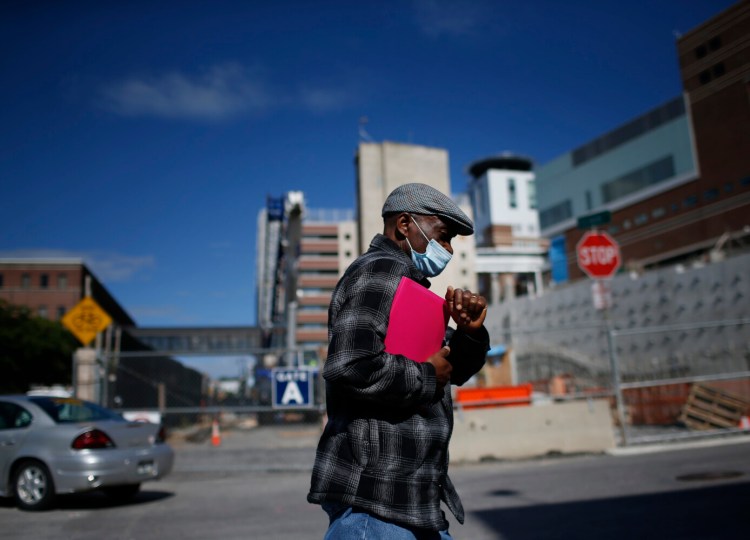Maine reported 467 new cases of COVID-19 on Friday, a slight easing of case counts that adds to other signs that the latest surge is starting to subside.
However, even as the rate of new infections, positive test rate and number of hospitalizations are declining, there are still parts of the state where the virus is spreading aggressively. No one knows if the overall declines will continue, although some state and national experts say the growing number of people who are either vaccinated or immune because of past infections could prevent another major surge.
“There’s a lot of variability,” said Dr. Dora Anne Mills, chief health improvement officer for MaineHealth, the parent organization of Maine Medical Center in Portland and seven other hospitals in the state. “Yes, overall our numbers are coming down, but there’s still pockets where there’s a lot of pandemic activity.”
The seven-day average of daily new cases dipped to 519.9, down from 591.6 a week ago, but up from 316.7 a month ago. Four additional deaths were reported Friday.
Since the pandemic began, Maine has recorded 94,348 cases of COVID-19, and 1,070 deaths. While Maine’s trajectory appears to be headed downward, much of the United States already has experienced significant declines in COVID-19 cases in recent weeks. Maine is currently 14th highest in virus prevalence, according to the Harvard Global Health Institute, with 41 cases per 100,000 population, compared to a nationwide average of 30 per 100,000 population.
Mills said the trends, while improving overall, are uneven in Maine. There are continued spikes of the virus in counties with lower vaccination rates, while counties with higher vaccination rates, such as Cumberland County, continue to experience lower infection rates.
While it’s unknown what will happen next – and the emergence of new variants is always a threat – Mills said it appears Maine and the nation are transitioning from a pandemic to an “endemic” disease, similar to the flu. When a disease is endemic, there are flare-ups and outbreaks and the disease is still a threat, especially to the unvaccinated, but the disease is not so widespread that it can cause major disruptions to society.
Mills said Denmark, which lifted pandemic restrictions in September, could be a good harbinger for the near future, especially in high-vaccination areas like Cumberland County. Seventy-five percent of Denmark’s total population is fully vaccinated, case counts are low and society has largely returned to pre-pandemic norms.
But Mills said while Denmark’s vaccination rates are fairly even, the wide disparity in immunization rates between Maine’s counties, or even between rural, suburban and urban parts of the same county, poses a risk.
“Vaccine rates are critical at the community level, not just the state level,” Mills said.
Cumberland County’s vaccination rate is currently 76 percent of the total population, and in the coming months it will likely climb several percentage points higher as employer mandates kick in and children ages 5-11 become eligible, likely in November. The statewide vaccination rate is about 66 percent.
High vaccination rates combined with immunity among the unvaccinated who have gotten sick with COVID-19 will eventually squelch opportunities for the virus to find hosts to infect.
The combination of increased vaccinations, the delta variant having already swept through much of the unvaccinated population and promising new antiviral pills expected to come on the market soon has led to many scientists projecting better pandemic conditions in the U.S. in the coming months.
“I think this delta wave is probably the last major surge of (COVID-19) infection that we have in the U.S., barring something unexpected happening,” Dr. Scott Gottlieb, former FDA director, said in national media interviews this week.
Across the U.S., COVID-19 hospitalizations have decreased 28 percent, from 81,725 on average two weeks ago to 63,921 now, according to the U.S. CDC.
In Maine, the number of people hospitalized with COVID-19 continues to drop precipitously. As of Friday, there were 153 people hospitalized, including 46 in critical care and 22 on ventilators. Over the last two weeks, hospitalizations have decreased by 45 percent and the number of critical care patients has dropped by 80 percent.
The positivity rate also has declined in Maine, from about 6 percent a few weeks ago to 4.43 percent on Thursday. When positivity rates are lower, that’s a sign that most symptomatic cases of the disease circulating are being reported, which leads to public health strategies like isolation and quarantine being more effective at tamping down transmission.
On Thursday, the Maine Department of Education released updated data on positive cases and outbreaks in public schools. There have now been 2,910 cases among staff and students since the school year began, an increase of 332 cases over last week. Five additional schools also reached outbreak status, bringing that total to 113.
Meanwhile, many parents are eagerly anticipating federal approval for COVID-19 vaccines for 5- to 11-year-olds. Pfizer has submitted data to the Food and Drug Administration and formally asked for approval for elementary-aged children, and that approval could come shortly before or after Halloween.
Currently, 883,680 Mainers are fully vaccinated, representing 65.7 percent of the state’s 1.3 million residents. Of the 1.2 million people currently eligible for the vaccine, those 12 and older, 74.6 percent are vaccinated.
Among racial groups in Maine, whites lag minority populations in vaccine uptake, with 59.9 percent of the white population fully immunized against COVID-19, compared to 83.9 percent of the Black population, 80.1 percent of Asians and 66 percent of the Native American population.
There’s also wide disparity in vaccination rates among counties in Maine, with Cumberland County at 76 percent of its total population immunized, and Knox and Lincoln counties clearing 70 percent vaccinated. At the other extreme, Franklin, Piscataquis and Somerset counties have 55 percent or less of their populations immunized.
Send questions/comments to the editors.




Comments are no longer available on this story